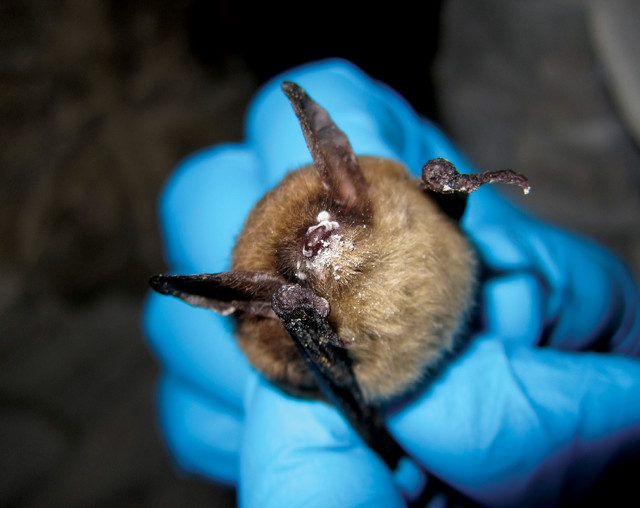
by Mary Caperton Morton Thursday, July 14, 2016

White Nose Syndrome, seen here on a northern long-eared bat from Illinois, has killed millions of bats in North America since 2006. Credit: University of Illinois/Steve Taylor, CC BY 2.0.
White Nose Syndrome has devastated bats across North America in recent years, but possible genetic resistance to the fungus has now been identified in some species of Asian bats. Researchers comparing North American and Chinese bat populations in a new study have found lower levels of infection — and greater capacities for recovery — in bats from five cave sites in China.
The scientists sampled bats at hibernation sites in the U.S. Midwest and northeastern China that are at similar latitudes and have similar winter climates. “Uniformly, across all the species we sampled in China, we found much lower levels of infection — both the fraction of bats infected and the amount of fungus on infected bats were lower than in North America,” said co-lead author Joseph Hoyt of the University of California at Santa Cruz in a statement.
The fungus that causes White Nose Syndrome, Pseudogymnoascus destructans, is native to Asia and Europe, and Eurasian bats appear to have developed a genetic resistance to the fungus over time. North American bats, however, have no such resistance, and since the fungus was introduced on the continent sometime in the mid-2000s, millions of bats have died after being weakened by the fungus while in winter hibernation. “This is the first study to compare disease dynamics in an endemic region and a region where the pathogen is invading, and the results can help us understand the course it might take in North America,” Hoyt said.
The explanation for the Asian bats’ resistance is still not fully known, but it’s been thought to involve a combination of host resistance to infection, host tolerance of the fungus, lower transmission rates due to smaller population sizes, and/or lower fungal growth rates due to environmental factors. The results of the new study point to host resistance as the most important factor, the researchers found, although it’s not necessarily the same for every species. “It could be differences in the skin microbiome in one and hibernation behavior in another,” said co-lead author Kate Langwig of Harvard University.
© 2008-2021. All rights reserved. Any copying, redistribution or retransmission of any of the contents of this service without the expressed written permission of the American Geosciences Institute is expressly prohibited. Click here for all copyright requests.